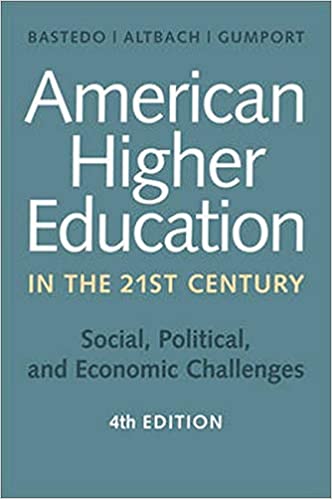You have /5 articles left.
Sign up for a free account or log in.
 American Higher Education in the 21st Century: Social, Political, and Economic Challenges by Michael N. Bastedo (editor), Philip G. Altbach (editor) and Patricia J. Gumport (editor)
American Higher Education in the 21st Century: Social, Political, and Economic Challenges by Michael N. Bastedo (editor), Philip G. Altbach (editor) and Patricia J. Gumport (editor)
Johns Hopkins University Press, fourth edition, published in March 2016
Any serious student of higher education will own a copy of American Higher Education in the 21st Century: Social, Political, and Economic Challenges.
Over the years, I've made earnest (if intermittent) attempts to get through all the 17 chapters in this collection. The result of my efforts might generously be described as a form of targeted reading success.
I would spend time with the chapters most closely aligned with my areas of immediate academic interest (teaching and learning, technology, etc.) and skim or skip over chapters further afield from my daily campus work (such as the legal environment and state-level policy).
There is nothing wrong with this approach to reading American Higher Education in the 21st Century. An advantage of an edited collection is the ability to pick and choose.
It was not until the audiobook version became available this June that I finally read (listened) to the volume from cover to cover.
A 24-hour and 27-minute audiobook seems long. But one thing I learned is that an audiobook is a surprisingly optimized medium for a volume of edited chapters.
Each day I'd get on my electric bike, put one earbud in one ear (leaving the other to listen for cars), and ride for the length of time it took to finish one chapter. Seventeen electric bike rides later, I'd finished the book.
The other thing I learned from listening to the entire book with my ears -- as opposed to reading select chapters with my eyes -- is that the sum of American Higher Education in the 21st Century is more enlightening than its parts.
This is an edited volume that hangs together. Each chapter dives deeply into a topic related to the history, current issues, macro forces and future challenges of postsecondary education.
Individually, the chapters cover an enormous amount of data and detail on higher education history, trends, policies, data, controversies and challenges. Collectively, the chapters in American Higher Education in the 21st Century cohere into a portrait of an ecosystem in transition.
It is hard to read this edited collection without coming away with the impression that: 1) things are changing surprisingly quickly at institutions across the postsecondary spectrum, and 2) given the enormous challenges that colleges and universities face in terms of demographic trends, public disinvestment and rising costs -- that things aren't changing fast enough.
A couple of things did surprise me about American Higher Education in the 21st Century.
First, I was fascinated by the progressive orientation of the chapters.
The scholars who contributed to this collection are true believers in the power of higher education to advance society (through research) and contribute to the economic and social mobility of its graduates (though learning and credentialing). Higher education comes across in the collection as society's prime engine of opportunity.
Beyond enthusiasm for the project of higher education, a consistent theme that runs through the chapters is a concern that the current structure of higher education is reinforcing social and economic inequalities.
Higher education tends to mirror, and perhaps contribute to, the growing levels of economic stratification and wealth concentration that have been accelerating for the past few decades.
My second surprise is that beyond a couple of the chapter authors, I was not previously aware of most of the scholars who contributed to this collection.
The authors of the chapters come mostly from professors who specialize in the scholarship of higher education.
Where American Higher Education in the 21st Century is most often read may be a function of the book's authors. My understanding is that American Higher Education in the 21st Century is a foundational text in graduate programs that train future postsecondary practitioners (Ed.D. programs) and future scholars of higher education (Ph.D. programs).
What I'd love to see over the next few years is more intermixing of the tribes of education professors who study higher education (the sorts of people who wrote and read this book) and the nonfaculty educators who are increasingly integral to teaching and learning at our colleges and universities.
In my fantasy world, faculty from schools and departments of education will combine with instructional designers and media educators and educational developers to create a new book club.
The first book that this new book club would discuss should be American Higher Education in the 21st Century.








